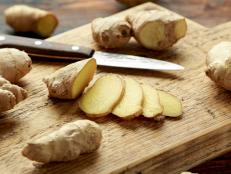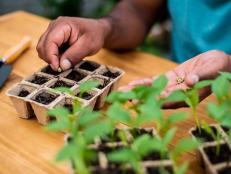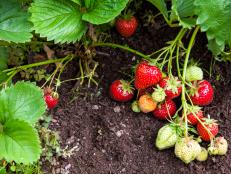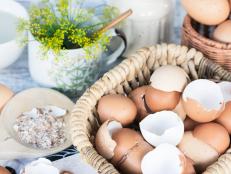How to Grow Fruits and Vegetables in Your Apartment, According to an Urban Farmer
An apartment farm harvest is possible if you keep these tips in mind.

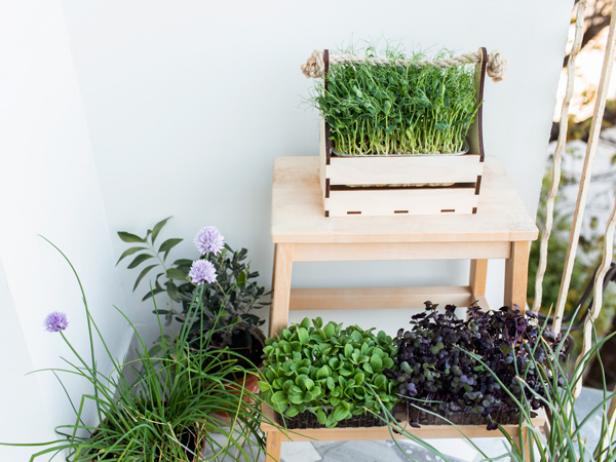
Anastasiia Krivenok/Getty
You may have dreams of planting your own vegetable garden, harvesting fresh produce and dining farm-to-table every night. Sounds pretty good — if only you had a yard. Or a rooftop. Or even another 100 square feet. But just because you live in an apartment doesn’t mean you can’t grow fruits and vegetables where you sleep and, yes, eat.
According to Nick Cutsumpas, a professional plant coach and urban farmer, better known to the world as Farmer Nick, growing edible plants indoors can be tricky. But it’s possible with practice, patience and of course, the right tips. (For anyone who is less interested in the fun of farming and just wants to eat, an efficient hydroponic system like The Farmstand from Lettuce Grow is another great option). Here, Cutsumpas shares his best advice for creating your own indoor farm.
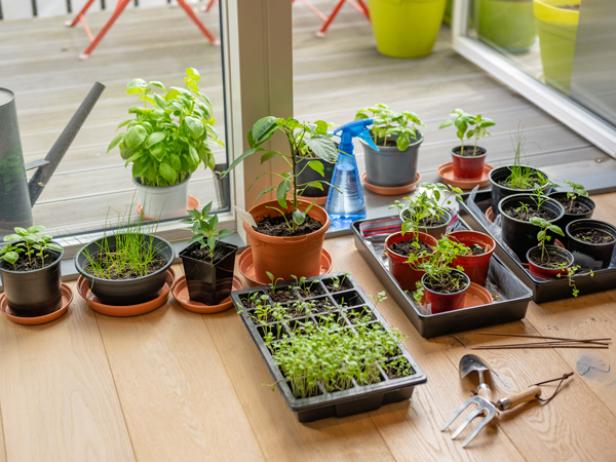
Malcolm P Chapman/Getty
Pick the Right Plants
As tempting as it might be to try to create a full-on working farm in your living room, consider which edible plants are best suited for an indoor environment. “When you’re growing indoors, it’s best to avoid fruiting or vegetable producing plants, meaning that they need pollination to produce the fruit in question,” says Cutsumpas. “I know people who will literally take a paintbrush and fertilize the flowers by hand, but you still won’t get a big yield.”
Instead, resilient leafy greens and herbs, such as kale, cabbage, romaine lettuce, microgreens, dill, cilantro, rosemary and thyme, are the way to go. Buy what your palate calls for, and don’t be afraid to experiment. Many farmers’ markets and grocery stores offer seedlings that make starting a new plant easy for beginners.
Maximize Your Space
Terracotta pots and grow bags are popular planter options because their porous, breathable material helps keep roots healthy and prevent overwatering. For most leafy greens and herbs, Cutsumpas recommends buying a planter that’s between 6-12 inches in diameter. “You don’t need 12 inches unless you’re planting a bunch of things in one,” he says.
However, if you want to harvest more frequently or aren’t confident that you're going to get a full head of lettuce with your lighting conditions, go ahead and overcrowd your pot. “Instead of four spinach plants in a 10-inch planter, grow 12, and harvest the baby spinach. Harvesting at different stages is a great way to maximize your space, and also get different flavors and textures in your food.”
Give Your Plants Some Sun — Lots of It
If you’re wondering how much sunlight your edible plants need, here’s a simple rule to go by: as much as possible. “Even the brightest indoor conditions often don’t not match what you get outside,” says Cutsumpas. “Cool weather plants like lettuce that require more shade still need at least 4-6 hours of direct sunlight a day.” The closer to the window, the better (a south-facing window is usually best because it gets the most light throughout the day). If your plants are still struggling, a supplemental heat lamp should do the trick.
While window space is prime real estate, it also requires careful monitoring, particularly in cold climates when winter drafts might come through. Another caveat, says Cutsumpas, are radiators and window heaters which can dry out soil. To ensure you’re watering enough, Cutsumpas recommends checking the soil with chopsticks. Similar to the popular baking hack, if the chopstick comes out clean, the soil is perfectly moist. Just remember to water evenly and check around the pot for dry pockets.
Master the Art of Harvesting
The good news: under the right conditions, you can turn over a leafy green crop in about 45 days. The bad news? “If you harvest it all at once, it’s like, great, 45 days for one salad,” says Cutsumpas. To avoid this frustrating scenario, Cutsumpas uses two different harvesting methods. The first, succession planting, involves starting seeds under grow lights once the older plants are about halfway through their grow cycle. “When you’re ready to harvest, you have 2-week-old seedlings you can immediately plant so you don’t have to wait another 45 days. You’re cutting that lead time in half.”
His other method, cut and come again, works with large, hearty greens like lettuce and kale. Rather than harvesting the entire plant, take only the outside leaves so it can continue to grow. “You’re not going to get as much of a harvest, but if you have five to seven plants there, you can have a nice garnish or something to add to your salads and brighten up your meals.”
Place Fruiting Plants Outdoors
Not everyone is so lucky to have an apartment with outdoor space, but if yours does, you might consider using the opportunity to try raising fruit- or vegetable-producing plants that require insects and birds for pollination. Two of Cutsumpas’s favorite options for urban settings are cherry tomatoes and sugar snap peas. “When you get outside, even on a fire escape, you are battling the elements,” he says. “The birds, the crows, and in New York, the rats. They will get you. It’s the sad reality for many outdoor gardeners that you will lose 20-40% of your crop to the animals. With cherry tomatoes, you get so many, 20% of 300 tomatoes isn’t bad.” Both plants also grow exceptionally fast and can reach 8-10 feet tall in a pot, making them a beautiful addition to a small patio, balcony or fire escape.
For a successful crop, remember to surround your tomatoes and peas with plants that will attract pollinators. “It’s something people don’t think enough about,” says Cutsumpas. “They put out their tomatoes and say ‘Hey I only got 10 tomatoes this year what happened?’ You didn't create an environment that was inviting.” For a truly tasty garden, Cutsumpas recommends using edible flowers like violas, nasturtium and marigolds.
Shop the Story
Related Content:



























